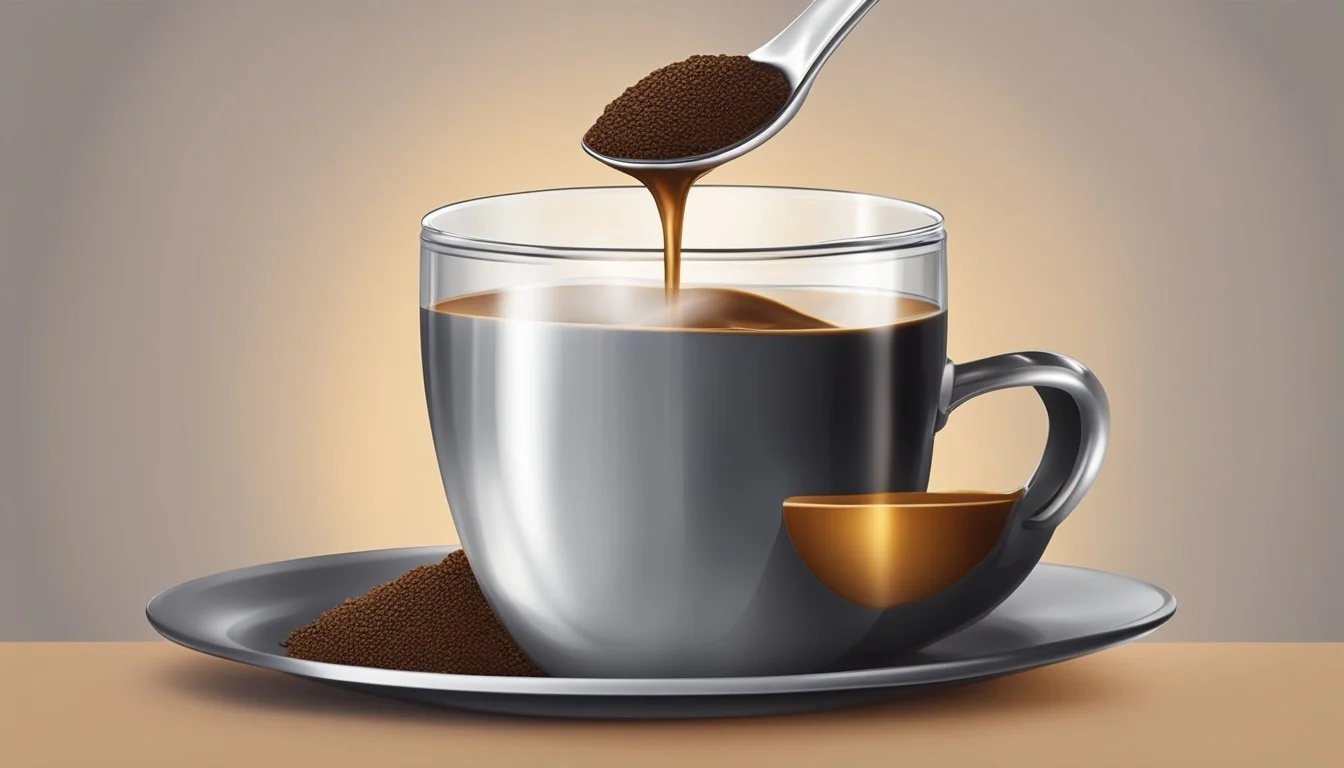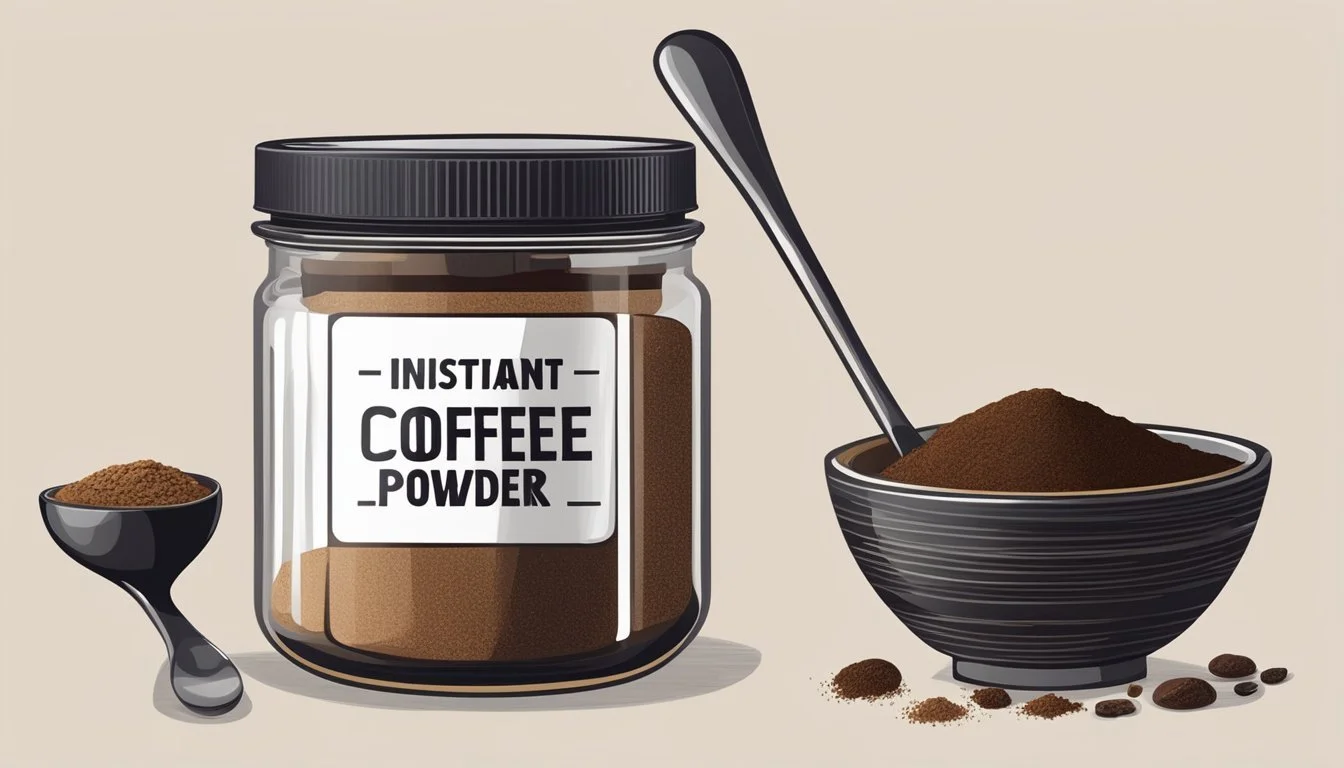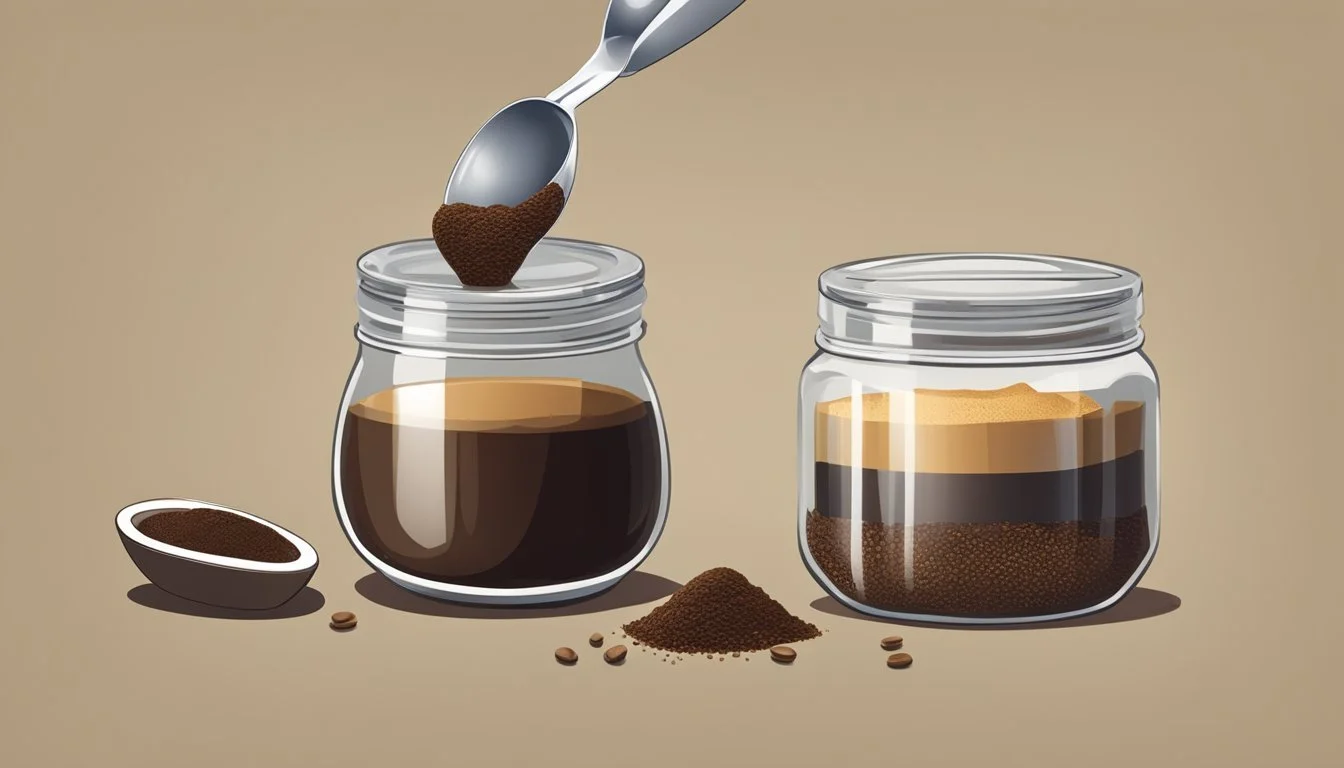How to Substitute Instant Coffee for Espresso Powder
A Simple Guide
Espresso powder is a popular ingredient among bakers and chefs for its ability to enhance the chocolate flavor in sweets and add complexity to savory dishes. It is a concentrated form of instant coffee, offering a rich, deep taste without adding liquid to the recipe. However, there may be times when espresso powder is unavailable or one simply prefers to use an alternative that is more readily accessible in their pantry.
Instant coffee emerges as a practical substitute, as it shares a flavor profile with espresso powder. When used in baking, instant coffee can provide a similar depth and aroma that complements chocolate, which is especially useful in recipes like cakes (how long do cakes last?), cookies, and brownies. The convenience of instant coffee lies in its wide availability and its ease of use, making it an excellent stand-in for espresso powder in various culinary applications.
Understanding Espresso Powder and Instant Coffee
To comprehend the essence of instant coffee and espresso powder, one needs to consider their distinct flavor profiles and textural characteristics. Additionally, the influence of coffee variety, such as Arabica or Robusta beans, plays a pivotal role in their outcome.
Differences in Flavor and Texture
Espresso powder is created from darkly roasted coffee beans ground extremely fine. The powder is known for its potent, concentrated flavor, which imbues a rich coffee taste into beverages and culinary preparations. Typically used in small quantities, espresso powder dissolves quickly in liquid, imparting a smooth, bold character without graininess.
Instant coffee, on the other hand, consists of dried coffee extract. Its grains are larger and offer a lighter taste with a more diluted coffee flavor compared to espresso powder. Instant coffee dissolves fully in water or milk, giving a quicker, more convenient method to procure a coffee-flavored drink, with a texture that ranges from smooth to slightly textured, depending on the granule size.
Varieties: Arabica vs Robusta
The two main coffee bean varieties used in instant coffee and espresso powder are Arabica and Robusta:
Arabica beans are prized for their smoother, more nuanced flavor with hints of sugar, fruits, and berries. They generally contain less caffeine and yield a coffee with higher acidity levels, which translates into a complex flavor profile suitable for both espresso powder and instant coffee.
Robusta beans have a stronger, more assertive coffee flavor, often described as earthy or nutty. They contain higher caffeine content and produce a heavier texture in the resulting coffee. Robusta beans are typically used in espresso blends to add depth and a creamy texture, which can be particularly noticeable when used in espresso powder form.
Substitution Basics
When substituting instant coffee for espresso powder, understanding the differences in concentration and moisture content is essential. The key is to match the strength and liquid balance in recipes.
Comparing Concentration and Strength
Espresso powder is essentially concentrated instant coffee, stronger in flavor. It is often employed in baking for its potent coffee taste, which enhances the richness in desserts (What wine goes well with desserts?). When using instant coffee as a substitute, one must consider that it is less concentrated. Therefore, a ratio adjustment is required to achieve a similar flavor profile.
Espresso Powder: More concentrated
Instant Coffee: Less concentrated, less intense flavor
Concentration Comparison:
Espresso Powder Instant Coffee (Dark Roast) 1 teaspoon 1 - 1.5 teaspoons
For recipes calling for espresso powder, use an equal amount of dark roast instant coffee, or slightly more, to replicate the intensity.
Adjusting for Moisture and Liquid Content
The moisture content in instant coffee and espresso powder can affect the texture of baked goods. Espresso powder, being more finely ground and concentrated, has less moisture and thus adds less liquid to a recipe. Instant coffee, especially when used in larger quantities to match the strength of espresso powder, can introduce additional liquid.
Moisture and Liquid Adjustment:
Add instant coffee directly to the dry ingredients.
Reduce other liquid sources in the recipe slightly if adding more instant coffee than espresso powder would have required.
By accounting for these variables, one can successfully use instant coffee as a substitute for espresso powder.
Culinary Applications
Substituting instant coffee for espresso powder is a practical solution in various culinary applications, particularly when a recipe calls for the rich and concentrated flavor of espresso powder. The following sections discuss how instant coffee can be used effectively in baking, enhancing desserts, and savory recipes.
Baking with Coffee Flavors
When one bakes cakes or other chocolate desserts (What wine goes well with chocolate desserts?), instant coffee can be used to enhance the coffee flavor. A good rule of thumb is to use a 1:1 ratio when replacing espresso powder with instant coffee. For an intensified flavor, dark roast instant coffee is preferable for its robustness which parallels the concentrated nature of espresso powder.
Chocolate Baked Goods: Enhance the chocolatey depth by adding a teaspoon of instant coffee to the dry ingredients.
Non-Chocolate Baked Goods: Use instant coffee in minimal amounts to avoid overpowering the recipe's primary flavors.
Enhancing Desserts and Sweets
In a recipe for sweets or dessert, instant coffee complements chocolate by amplifying its flavor without the bitterness that might come from cocoa powder. Instant coffee dissolves easily, making it particularly well-suited for creamy desserts (What wine goes well with creamy desserts?) or icings where a smooth texture is vital.
Chocolate Ganache: Incorporate a half-teaspoon of instant coffee to elevate the richness.
Dessert Glazes: Dissolve instant coffee in a small amount of water before adding to ensure even distribution throughout the glaze.
Coffee in Savory Recipes
While less common, coffee can be an intriguing addition to savory dishes. Instant coffee provides a subtle richness to rubs and sauces, adding complexity to the overall flavor profile of the dish.
Spice Rubs for Meats: Blend with other spices, using a ratio of one part instant coffee to two parts of other rub components.
Sauces and Gravies: Stir in a small amount of dissolved instant coffee to deepen the umami flavor without adding bitterness.
Specific Ingredient Substitution Guidelines
In the realm of baking and cooking, precise substitutions can be crucial to replicating a desired flavor profile. This section distills the essence of swapping instant coffee for espresso powder, while also addressing necessary adjustments in other ingredients.
Instant Coffee as an Espresso Powder Substitute
Instant Coffee: An accessible alternative for espresso powder, instant coffee lends a similar coffee flavor to dishes, although it is less concentrated. For every teaspoon of espresso powder a recipe calls for, one can typically use a teaspoon of instant coffee. However, dark roast instant coffee is preferable, as it aligns closer to the robustness of espresso powder.
Texture Considerations: Instant coffee should be dissolved in a small amount of warm water before adding to the batter, to mimic the fine texture of espresso powder.
Adjusting Other Ingredients Accordingly
When substituting instant coffee for espresso powder, it's often prudent to make additional tweaks to your recipe:
Sugar: Since instant coffee is typically less bitter, you may want to reduce the sugar content slightly to maintain the balance of flavors.
Liquids: If you dissolve instant coffee in water, adjust the overall liquid content in the batter to ensure consistency remains unaffected.
Table illustrating ingredient adjustments:
Ingredient Espresso Powder Substitute with Instant Coffee Adjustments Needed Espresso Powder (1 tsp) Use as is Instant Coffee (1 tsp) Lessen sugar; tweak liquid content if necessary Sugar To taste To taste (possibly less) Use less if the instant coffee is milder Liquid As required As required (with considerations) Reduce liquid amounts to account for coffee solution
By attentively adhering to these guidelines, one preserves the integrity of the dish, both in texture and taste.
Tips and Tricks for Success
When substituting instant coffee for espresso powder in recipes, it's crucial to maintain the intended flavor profile and texture of the dish. The following subsections offer guidance on how to achieve the best results in your culinary endeavors.
Utilizing Cocoa Powder Types
In baking, natural cocoa powder can be combined with instant coffee to enhance chocolate flavors without altering the dessert's acidity. Natural cocoa powder is more acidic and can contribute to the leavening process when paired with baking soda.
Dutch-processed cocoa powder, having been treated to neutralize acidity, is less reactive with leavening agents and offers a smoother, mellower taste. Incorporate Dutch-processed cocoa powder for a more balanced and less bitter taste, complementing the coffee's sharpness.
Balancing Flavors and Acidity
The acidity of instant coffee may differ from that of espresso powder. To avoid a bitter outcome:
Add a pinch of baking soda: This can neutralize excess acidity in the coffee.
Combine with cream or milk: Dairy can moderate sharp flavors and lend a creamier texture to your desserts.
For a richer, more chocolatey experience, one can experiment with small additions of instant coffee without overwhelming the cocoa's natural essence.
Determining the Right Amount to Use
The potency of instant coffee can vary, so adjustments are often necessary to match the intensity of espresso powder. Start with the following ratios and adjust to taste:
Desired Flavor Intensity Instant Coffee Substitute (per 1 teaspoon of Espresso Powder) Mild 1 teaspoon of instant coffee Medium 1 1/2 teaspoons of instant coffee Strong 2 teaspoons of instant coffee
Dissolve instant coffee in a small amount of hot water before adding to the recipe to ensure it distributes evenly throughout the mixture.
Additional Considerations
When substituting instant coffee for espresso powder, one should be mindful of caffeine content and any dietary restrictions, as well as the potential health benefits and antioxidants present in these coffee products.
Caffeine Content and Dietary Restrictions
The caffeine content in instant coffee can vary, generally providing less caffeine compared to espresso powder. For individuals sensitive to caffeine or those who monitor their intake for dietary reasons, instant coffee can be a suitable alternative when used in moderation. One should check the labels for exact caffeine content and adjust the amount used in recipes accordingly.
It's also important to note that some instant coffee options may come with added flavors or sweeteners. Individuals with dietary restrictions or sugar sensitivities should opt for pure instant coffee without these additives.
Health Benefits and Antioxidants
Coffee beans, the source of both espresso powder and instant coffee, are known for their antioxidants, which can contribute to overall health. Here's a brief comparison:
Espresso Powder: Typically contains a higher concentration of antioxidants due to the finer grind and concentration.
Instant Coffee: Still retains antioxidants, but the freeze-drying or spray-drying process it undergoes may result in a slight reduction.
Substituting instant coffee for espresso powder won't significantly alter the antioxidant benefits one receives from their recipe. Nonetheless, the nutritional profile can slightly differ, and it's helpful for those seeking the added health benefits to consider the type of coffee product they incorporate into their diet.
Popular Recipes Using Coffee
Coffee is a versatile ingredient that enhances flavor in various desserts. It adds depth and intensity, making it a favorite in both classic recipes and innovative modern creations.
Tiramisu and Other Classic Desserts
Tiramisu is perhaps the most celebrated dessert that utilizes coffee. Its delicate layers of coffee-soaked ladyfingers, rich mascarpone cheese, and a dusting of cocoa powder showcase coffee's ability to complement and amplify other flavors. The balance of ingredients is key, with a strong espresso coffee often chosen to impart the desired coffee essence.
In addition to tiramisu, chocolate recipes frequently include coffee to intensify the chocolate taste. Desserts such as chocolate cakes and brownies can benefit from a hint of coffee, which can be integrated in the form of instant coffee to create a more complex and rich flavor profile.
Innovative Uses in Modern Baking
Modern baking continues to push the boundaries with unique coffee incorporations. Bakers might create a coffee-infused caramel drizzle for a twist on a classic caramel slice, or integrate coffee into icings and frostings for an added dimension of taste.
Coffee Chocolate Chip Cookies: Add instant coffee granules to the dough for a mocha flavor.
Coffee-Flavored Creams: Instant coffee is dissolved and whipped into creams to top cakes or filling for doughnuts.
In all instances, coffee is not just an add-on but an essential component that transforms a simple sweet into a nuanced treat. Whether it's a time-honored recipe like tiramisu or an imaginative concoction from a contemporary kitchen, coffee's robust flavor is the secret weapon for a successful dessert.







